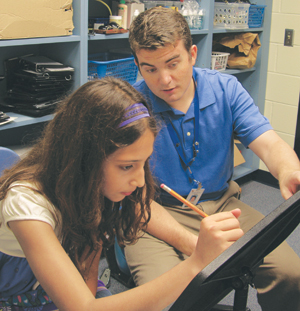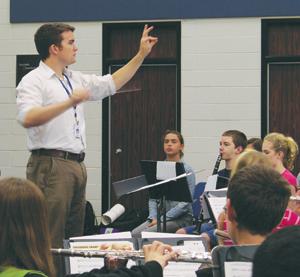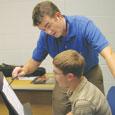 The band program at the Barbers Hill Independent School District, about 30 miles east of Houston, Texas, is always looking for ways to retain more students. Each fall school begins with a fairly large sixth-grade band that includes roughly half the class, but by seventh grade, half of those students or more drop out.
The band program at the Barbers Hill Independent School District, about 30 miles east of Houston, Texas, is always looking for ways to retain more students. Each fall school begins with a fairly large sixth-grade band that includes roughly half the class, but by seventh grade, half of those students or more drop out.
The district has a fairly large band program with approximately 460 students and four directors who team teach at all levels. We compete with the same things all bands do: the allure of athletics and other electives, peer pressure, and the general difficulties of fickle teens. When one of our principals and head director, Bill Blackburn, charged the band staff to keep more participants in the program, I looked for ways to make band cool – something that would light that spark and keep students interested – while still keeping it educationally valuable.
After reading Dan Albert’s article in the January 2009 issue of The Instrumentalist describing how the Longmeadow Band commissioned Michael Colgrass to compose a work for band, I felt inspired to do the same. At first I imagined it would be great to bring in a world-class composer to write an original work for our students and encourage them to compose. In reality, the funds for such a venture were not available, and the activity would require at least a year of planning and fundraising. By the time we commissioned a composer and received the work, the band program might be through two years worth of sixth graders who would not have that experience to spark them.
Albert’s article reminded me of a masterclass of Frank Battisti’s that included a discussion of his experiences as a conductor and music educator, particularly his time in Ithaca, New York. He told the audience that each of his high school students had to compose an original work as a requirement of their participation in band.
My mind jumped ahead with new ideas to keep more of my students in band. While sixth-grade students might not be ready to compose original, full-scale works, the other directors and I could work together and simplify an approach to composition, developing clear guidelines for them.
The students certainly were capable of writing original melodies. With enough good melodies, I felt confident that I could work them into an enjoyable piece for the students to play. It would be a piece they would have a hand in composing. In fact, the students would essentially be the composers, and I would just arrange the work in a way to make it appealing. The outcome of our approach included six steps that introduced enough information to help students write music.
Step 1: Introduction to the basics of writing music.
At the beginning of the school year, sixth-grade band students spent the first week of class learning the basics of writing manuscript. They learned how to notate music by hand and read rhythmic values from whole notes through to eighth notes, with the corresponding rests and their correct positions on the staff.
This is also the point when we taught students to write and identify bass and treble clefs and read the pitches on the corresponding staves. If we did not start with this step at the beginning of the year, I would have had to include it later in the curriculum for the composition unit.
Step 2: Introduction to composing music through improvisation.
In late January we devoted a day to discussing improvisation and composition. It began with introducing students to the B-flat concert pentatonic scale and, after a brief demonstration, encouraging them to volunteer to improvise using those notes. While many students were hesitant, a few brave souls took the lead. You could actually hear everyone growing more confident as they figured out how different notes function in the tonality.
Some students began to repeat motives, and others drifted further from the tonic note and back while still others added interesting dynamics and rhythmic flare. Most students stayed within the tiny range of an octave, but some kids really began to explore their instrument’s range. One of the highlights of that lesson took place when a trumpet player discovered low G. He had played down to a low A, then when he meant to play the D above, the pitch went down instead of up. His eyes widened when he hit the note; he just kept playing it, repeating it, and adding some rhythm to the pitch. “I’m not sure if that was one of the right notes, but I liked it,” he said later.
When we finished improvising, I proudly informed the students that they were now composers and that what they did was similar to what many of the greatest composers did to create their great works. The only difference was that those brilliant minds wrote it all down.
Using improvisation to encourage creative thinking, we introduced important music vocabulary: Pentatonic scale, improvisation, and composition; melody, motive, tonic, and harmony. We also played some famous melodies and motives as examples of what students should already be familiar with.

Step 3: The composition assignment.
Once students understood those ideas, we gave them a first assignment. Using carefully established parameters, they had one month to compose two pentatonic melodies of four or eight measures and four pentatonic motives of one measure each. They could turn in their work for review and advice at any time before that, and they could ask questions at any point in the process. The guidelines included:
• You have to use the notes of the B-flat concert pentatonic scale (each instrument’s specific pitches were included on the hand out).
• All melodies and motives are to be in 44.
• Percussionists can compose two pentatonic motives and two rhythmic motives.
• Write something you will be able to play, not something that looks hard and flashy. Only use notes you can play.
• You may not use whole notes or rests for your motives. You may not use whole rests in your melody. In motives and melodies you may also use half notes, quarter notes, eighth notes, and their corresponding rests. Percus-sionists can use 16th notes in their two rhythmic motives, but not 16th rests.
• You have to start on concert Bb, D, or F. You have to end your melody on concert B flat (again, each instrument’s specific pitches are included in the handout).
In late February we collected the assignments. Of 150 students, about a dozen students were a few days late and only two never submitted their work.
Step 4: Arranging a work for band.
I spent most of the spring break sorting through the assignments, hoping to find enough suitable melodies and motives to create a work. To my surprise, there were more good melodies than I had expected. The vast majority of the assignments had at least one melody and some motives that fell within the guidelines; some actually suggested that the students had sat down with their instruments and worked hard to find something that sounded cool. Now, instead of digging for a handful of useful material, I would have to narrow down the students’ efforts to those that would be most appropriate for the concert band work.
With such a luxury, I thought it would be best to create a work with multiple movements so as to include as much of the students’ work as possible. As I hammered out a framework, it seemed logical to have two fast movements with a slow movement in between, creating each in a classical form and later discussing the differences with the student composers. With a working title of Symphony in Bb, the first movement was a modified sonata form, the second movement was in ternary form, and the third a rondo. I usually extended the few four measure melodies I used by repeating them, adding a half cadence in the middle. Most of the melodies, though, required little in the way of such editing. Although I did not add accents to percussion motives, I added articulation to the melodies and the other motives.
After spring break, we began work on the piece one movement at a time without telling students whose melodies had been selected. By doing this, it kept everyone excited to hear if their music was somewhere in the piece. As the students began to polish each movement and play through all the music on the page, we introduced the different musical forms and we discussed why form was important.
Students came to the conclusion that form was important because it gives structure to music and makes it easier to understand. One bright student even compared sonata form to the chapters of a book, in that each part of the form informs the next. The beginning chapters lead up to something, the middle chapters created excitement and tension, and the closing chapters resolved the tension that was created in the middle. I wish I had some of that clarity in freshman theory.
Once the three movements had been rehearsed, we announced the contributing composers – 13 of them – whose music was part the symphony. Before the announcement, I stated that we had received many fine assignments and could have included many more in the work; however, the constraints of time (both rehearsal time and the length of music students could perform) were against us.
The 13 student composers were invited to a pizza luncheon with the campus principal, Barbara Ponder, who thought the project was a different, interesting idea. During the luncheon she asked questions about the creative process and influences of the composers and how it felt to hear the band perform their music.
As students learned to play the music, we asked everyone to brainstorm ideas for an engaging title for the piece. Students were given two weeks to submit ideas in writing, then the three band directors pared down the suggestions to a handful of the best ones for a student vote. We got involved only to quash a grass-roots campaign from the trumpets and saxophones who wanted the title to be Grand Mountain Fudge Cake.
In the end the title that garnered the most votes was Eagles Take Flight. The movements were “Rising Up,” “Soaring,” and “United As One.”
Step 6: Performance.
We gave the world premiere of Eagles Take Flight as part of the band’s annual spring concert, May 21, 2009. The music was well received, and the families in the audience were so proud of the work their students exhibited.
When 150 students signed up for sixth-grade band this year, the goal was to improve on the previous year’s retention of 80. Although it is impossible to know whether the composition project was the impetus, the enrollment numbers for the next year showed that approximately 100 students signed up for band. If composing didn’t convince students to remain, the excitement that the project generated helped to make band a fun, worthwhile time. In addition to that, every student in sixth grade band learned something about being creative through the art of composition.
Composing did not intrude on the band’s regular curriculum. The vast majority of rehearsal time focused on developing characteristic instrumental sounds and basic technique, with only 90 minutes of each student’s time devoted to composition over a three-month period. We hope to invite a professional composer to Barbers Hill’s schools in the future, but for now we are off to a good start. degree from Western Carolina University.






